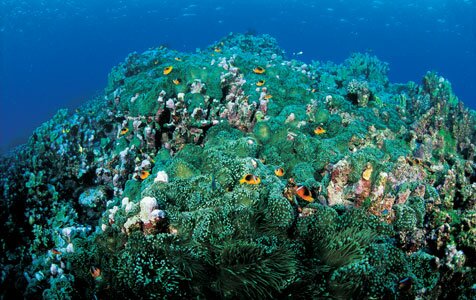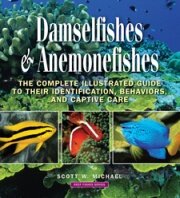Reef Fishes Volume 4
From Microcosm Aquarium Explorer
Author(s):
Pages: 256
List price: $64.95
Publisher: T.F.H. Publications, Inc.
Series: The Reef Fishes Series
Year published: 2008
ISBN: 1890087971
Description
The Complete Illustrated Guide to their Identification, Behaviors, and Captive Care
The much-anticipated fourth volume in Scott Michael’s landmark Reef Fishes Series brilliantly profiles hundreds of the species that are among the most popular among marine aquarists of all skill levels.
Covers the sprawling Family Pomacentridae—the brilliant damsels, chromis, sergeants, demoiselles, and gregories in all their amazing colors and diversity, as well as the many species of alluring anemonefishes (clownfishes) and their host anemones.
“A must-have reference book brimming with brilliant photography, hard-to-find care and feeding advice, and many new and exciting species.”
Each species entry includes: • Natural history and biology notes from the wild • Identification (more than 350 new color photos) • Behaviors • Foods and Feeding Tips • Selection and Buying Advice • Captive Care Techniques and Secrets.
Representing two decades of research, writing, and underwater photography, the Reef Fishes Series books provide authoritative coverage of hundreds of dazzling species, with their social behaviors, food habits, modes of reproduction, and expert advice for keeping them alive and healthy in the home aquarium.
Excerpt
 A coral bommie in the Banda Sea, Indonesia, is covered by a huge colony of Bubble Tip Anemones (Entacmaea quadricolor) with dozens of Red and Black Anemonefish (Amphiprion melanopus) pairs and individuals.
A coral bommie in the Banda Sea, Indonesia, is covered by a huge colony of Bubble Tip Anemones (Entacmaea quadricolor) with dozens of Red and Black Anemonefish (Amphiprion melanopus) pairs and individuals.
Amphiprion melanopus
(Bleeker, 1852)
Common Names: Dusky Anemonefish, Red and Black Anemonefish, Melanopus Anemonefish, Cinnamon Anemonefish.
Maximum Length: 12 cm (4.7 in.).
Distribution: Bali to the Society Islands, north to the Marianas, and south to the Great Barrier Reef and New Caledonia.
Biology: This fish is found in lagoons and on reef flats and reef faces at depths of 1 to at least 18 m (3.3. to 59 ft.). It is reported to feed primarily on planktonic copepods and algae. However, it will also eat small crustaceans, worms, tunicate larvae, sea spiders, barnacle appendages, and fish eggs (individuals tending a nest will eat infected eggs). The Dusky Anemonefish is usually found in the colonial morph of Entacmaea quadricolor and less frequently associates with Heteractis crispa and H. magnifica. The clusters of the cloning form of the E. quadricolor often cover large areas of the reef surface. These are occupied by aggregations of juveniles, subadults, and adult A. melanopus. As many as 150 individuals have been reported from a colony of E. quadricolor that covered an area of 36 sq. meters (387 sq. ft.).
Male-female A. melanopus pairs defend a territory that may consist of several of the small anemone clones. If the group of anemones is smaller, the adult pair may defend the entire colony. Juveniles tend to occupy smaller anemones at the periphery of the E. quadricolor colony, while the largest fish tend to inhabit the center of the anemone colony. Females are more aggressive than the males. Adults regularly displace smaller consexuals in established pairs or replace consexuals that disappear before a subadult can change sex and fill the vacancy (see A. frenatus for more on this phenomenon).
Juvenile Great Barrier Reef (A. akindynos) and young Spinecheek (P. aculeatus) Anemonefishes are occasionally found at the periphery of the colonies occupied by A. melanopus. I have also seen this species living in E. quadricolor next to H. crispa that contained A. clarkii.
The Dusky Anemonefish would occasionally attack their A. clarkii neighbors, and temporarily drive them out of their host. In Guam, this species will spawn an average of twice per lunar month. Spawning lasts about one and a half hours and usually occurs two or three hours after the sun sets. The average number of eggs per nest is 300. Ross (1977) estimated the annual fecundity of this species to be around 7,200 eggs.
Captive Care: This is a durable, potentially quarrelsome aquarium inhabitant. Adults are best kept with more aggressive tankmates. In a larger tank, it is possible to keep A. melanopus with more peaceful fishes. If you want to see it interact with a sea anemone, add an E. quadricolor (it tends to prefer the colonial form of this species). However, it will readily acclimate to the aquarium even if not kept with a host. These anemonefishes should be kept singly or in mated pairs, and should not be housed with similar species. It has been known to hybridize in captivity with the Fire (A. ephippium) and Tomato (A. frenatus) Anemonefish. Hoff (1996) reports that captive females deposit from 172 to 339 eggs per nest (with an average of 249). The rate of hatching is low in this species, but the survival rate of the larvae is relatively high. Eggs hatch in 8 to 10 days. Metamorphosis occurs on about the eighth day after hatching.
Aquarium Size: 30 gal. Temperature: 23° to 27°C (74° to 82°F).
Aquarium Suitability: 4.
Remarks: Adults of this species are usually brick red with black on the body, pelvic fins, and anal fins. There is a single head bar that can be blue or white. The juveniles may have one or two additional body bars. Females often have a blanched or whitish “face,” while in males the head is bright red. This species is very similar to the Tomato Anemonefish (A. frenatus) but differs in having black pelvic fins. Males are not bright orange like A. frenatus, but are red or dull reddish brown. Populations of A. melanopus from Fiji, Tonga, and the Society Islands, as well as the Coral Sea, differ in color from those found in other parts of the western Pacific. Those individuals from the three former locations are reddish orange overall with a white head bar and no black saddle, or black on the pelvic and anal fins (they look more like male A. frenatus).
Individuals from the Coral Sea can be orangish overall with a dark brown spot on the body, and often lack the head band.
Just Published - Now Shipping










